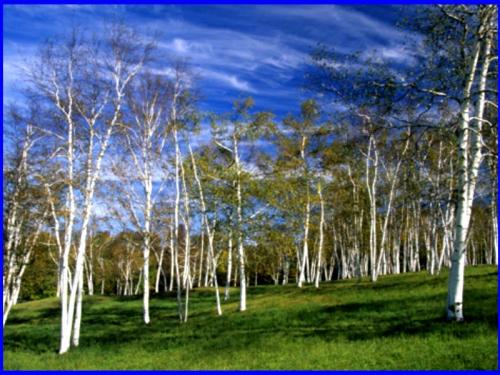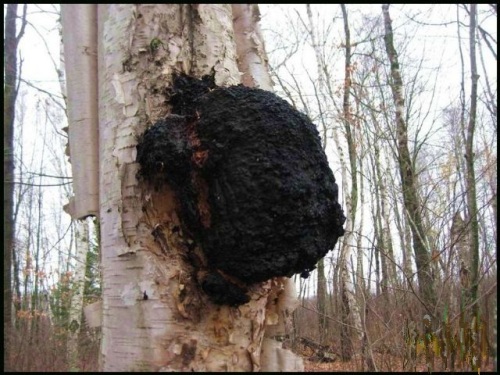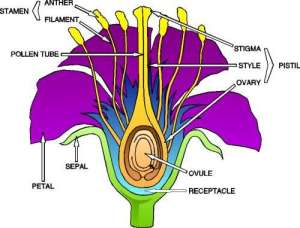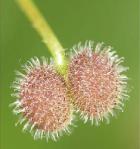Earth’s the right place for love:
I don’t know where it’s likely to go better.
I’d like to go by climbing a birch tree,
And climb black branches up a snow-white trunk
Toward heaven, till the tree could bear no more,
But dipped its top and set me down again.
That would be good both going and coming back.
One could do worse than be a swinger of birches.Excerpted from Robert Frost – “Birches”
Preparing to write about these lovely deciduous trees has been quite a journey.
I have found that what I know is only the tip of the iceberg of what I need to know. The White or Paper Birch is a tree that I am slowly becoming familiar with. My early relationship was one of taking for granted that this tree would always be here for me to sing to, climb and use as crafting materials. I did not ever imagine these lovely fast growing groves of trees could be used to heal, attract some of the most powerful healing fungi in the world or that they would one day be imperiled.
My father was a land surveyor and he sometimes took me and my siblings along for the day on his forays into the forested areas of Oregon. On a early summer day many years ago he took us on a walk along a coastal mountain stream. The White Birch was plentiful and lovely.
We came upon a White Birch which had a broken branch half hanging. He took some of the sap dripping from the broken tree, spread it over the wound, and then he took the shedding white bark for which it is known and used it to tie the branch back in place. This is just one of the “signatures” of this tree. Later I would learn that birch bark was used to set into a cast, the broken bones of humans. On that day long ago, my father gave me some of the sap to chew and told me that it would be good for my teeth and mouth. It was sweet and tingled in my mouth. I asked daddy about the bark. I asked if I could remove some naturally occurring shedding white bark without 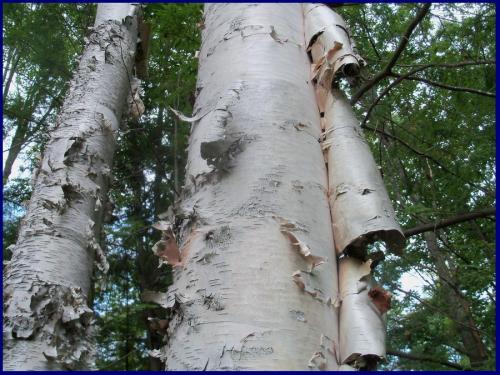 harming the tree. He told me that in other parts of the country, the bark was used to make canoes and to line baskets and wrap food and that it had probably been used as paper somewhere in the world. He told me there was time of year in the late spring and early summer when the bark was easy to remove without harming the tree. He told me the tree sap was very healing as was the bark and that is why he used it to repair the broken limb.
harming the tree. He told me that in other parts of the country, the bark was used to make canoes and to line baskets and wrap food and that it had probably been used as paper somewhere in the world. He told me there was time of year in the late spring and early summer when the bark was easy to remove without harming the tree. He told me the tree sap was very healing as was the bark and that is why he used it to repair the broken limb.
Later I used some of the bark to make clothes for my doll and I made a small pouch to hold special things. I made a small canoe that I could push across our pond. I found sanctuary in the birch grove and sat in silence to watch the wild birds skip from branch to branch. In late summer the tiny rounded samara became part of my secret cache of wild seeds.
This was my introduction to White Birch. It was easy to interact with the community of birch. I can imagine now that it is this easy relationship to the tree and bark that attracted the First People. It is also easy for humans to take this tree for granted, not respect it. As you will read, the White Birch is a powerful healer for both human and forest communities. It is a tree that welcomes the fungi mat (mycelium) and heals the wounds caused by fire, humans, disease and floods.
Betula papyrifera (Paper Birch, also known as American White Birch and Canoe Birch) is a species of birch native to the northern part of North America and the southern part of Canada. The species birch is found all over the world.
PREPARING THE WAY – Birch, Alder, Aspen
Some trees are steady and slow in growth reaching to the tops of forests they create an umbrella for the web of life. And, some trees are pioneers, growing fast, living a short time and creating a birthing platform for many other species. The White Birch is a pioneer species. The stands of White Birch come on fast and can grow only to about 20 meters high (65 feet). A healthy tree can live to be 40 or 50 years old. During their growth the pollen from birch catkins attract a great many pollinators that will bring life to other plants in the forest. The sap and bark attract a great many fungi that live symbiotically on the tree. The fungi are then dispersed into the disturbed soils to help create the forest mycelium mat. For a long time scientists and foresters thought the fungi found on the birch were a sign that the tree was dying. They thought the fungi were killing the tree. Now we know that the birch is a nurse tree to a great many beneficial fungi. It chooses which fungi will inhabit it and also has a chemical defense method that will trap certain fungi in the heartwood or on the outer barks. The sap actually has pesticide qualities. It detracts insects such as termites and certain bacteria that might do the tree harm. According to Grieve in her book A Modern Herbal, Birch tar was used to repel insects (p. 103)
Like the Red Alder and Aspen, the White Birch lives in symbiotic relationship with nitrogen-fixing bacterium. This relationship is called mutualism. In mutualism: plants gain nitrogen compounds, the bacterium gains carbohydrate and an environment with reduced oxygen. The plant then changes carbon dioxide to oxygen and releases it for human use.
White birch as a pioneer deciduous species is often found in groves on the edge of newly formed second-growth tree communities or near the edges of changing forests. This tree shows up in ecosystems that have been disturbed by fire, flood or human decimation. They can be found in open or dense stands of forest usually in an opening. They can be found in lowlands to lower mountain slopes in drained sites or along bogs and other wetlands. B. papyrifera requires high nutrients and sun exposure.
These trees do not live long. From the time they spring up and then die, can be as little as 20 years or as much as 50 years. It is easy to propagate and the young saplings are often found spouting from a cut stump. Like the Red Alder, the White Birch is a very important part of establishing the mycological forest community. Without these forerunners of forest health, there would not be a fertile soil and microbiological environment that would support the deep wild forest.
NAME
The name is a very ancient one, probably derived from the Sanskrit bhurga, ‘a tree whose bark is used for writing upon’ (Grieve, p. 103). The First Peoples of the Cascadian bio-region have names for this tree also:
Salish = âîçêáÛ – birch bark
âîçêálî, îçêá – white birch, paper birch, birch bark.
paper birch îçæálî, îçæá – birch; paper birch.
The English name is White Birch, Paper Birch or Canoe Birch
The Latin botanical name is: Betula papyrifera
LEAF
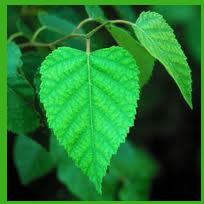 The leaf is alternate, deciduous, oval to round and sharp-pointed. The leaf of the White Birch can be longer when on young trees. The color is dull green above and paler and hairy below. The margins are doubly toothed. (Pojar and Mackinnon p. 47)
The leaf is alternate, deciduous, oval to round and sharp-pointed. The leaf of the White Birch can be longer when on young trees. The color is dull green above and paler and hairy below. The margins are doubly toothed. (Pojar and Mackinnon p. 47)
Learning the shape of the leaf is important because there are other trees that grow in similar environments that look much the same when young. For instance bitter cherry has a similar bark and structure but the leaf is oblong to oval, and less pointy.
The FLOWER AND THE SEED
The flowers, and thus the seeds, of white birch are arranged in a pendant cluster about an inch long which is referred to as a catkin. Male 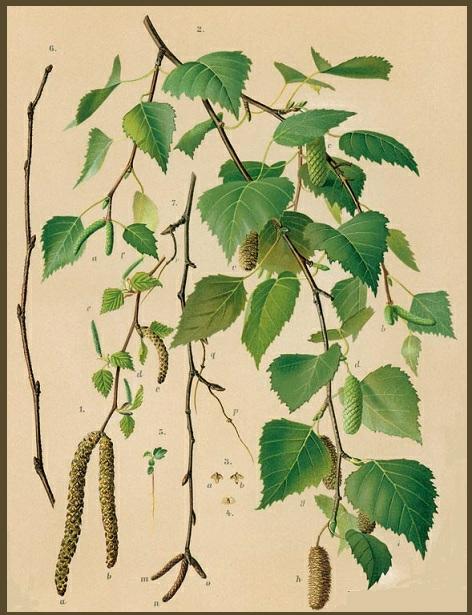 and female flowers are on separate catkins. When pollinated, the female flowers develop seeds, each of which is located on a scale in the catkin.
and female flowers are on separate catkins. When pollinated, the female flowers develop seeds, each of which is located on a scale in the catkin.
Male and female flowers grow in separate catkins and flower at the same time. Sometimes there will be young leaves emerging as the tree flowers. The buds for the male catkins appear in autumn, when it begins getting cold. During spring, the tassel-like catkin will produce yellowish or grayish green flowers that produce pollen with an aromatic scent.
Over the winter the catkins disintegrate, dispersing both seeds and scales. You can identify the species of birch from the shape of its scales or nutlets. Again, the white birch nutlet is round with wings that are broader than the body.
The male catkins will fall away from the tree, while the female catkins will form into cones in the summer. These cones vary from a deep brown to a tan, though they may also have a reddish color to them. During late summer, the cones will open and in autumn, the cones will fall, spreading their nutlets across the ground. The nutlets are then dispersed on the wind.
BARK
The tree is most familiar to us humans because of its bark. The bark peels in papery strips in late spring and early summer. The bark of this tree is commonly thought of as being white or grayish white, but also comes in yellowish or dark gray. It is often marked with brown horizontal lines of raised pores. The bark is highly weather-resistant. The wood itself is highly flammable and can be burned as firewood even when damp.
MEDICINE
Birch syrup is a sweetener made from the sap of birch trees, and used in much the same way as maple syrup. It is also used as medicine syrup. The sap is boiled down to produce birch syrup.
The same sap is fermented to make beer and wine. Birch beer is very popular in Northern Europe and a few areas of North America.
The oil is astringent, and is mainly employed for its curative effects in skin afflictions, especially eczema, but is also used for some internal maladies. Oil of wintergreen is distilled from its inner bark and twigs (Meyer p. 15)
The inner bark is bitter and astringent, and has been used in intermittent fevers. The bark is ground to a fine power and used to treat diaper rash. It is also used internally to treat a great many inflammatory and bacterial infections.
The vernal sap is diuretic. The resin contains zylitol, a disinfectant used as a natural tooth cleaner. However, it may also contain terpenes. Used in making turpentine, terpenes and terpenoids are the primary constituents of the essential oils of many types of plants and flowers. Essential oils are used widely as natural flavor additives for food, as fragrances in perfumery, and in traditional and alternative medicines such as aromatherapy. It was also reported that those who chewed the resin could get somewhat of a “buzz” (Pojar and MacKinnon p.47.
One of the chemicals that has been isolated from birch bark is called betulin. Betulinic acid, which is made from betulin, is being studied as a possible cancer treatment. Betulin has also been found in many other plants.
White Birch is used on the skin to treat warts, eczema, and other skin conditions. Promoters say that birch tea can be taken internally as a diuretic or a mild sedative and that it can be used as a treatment for rheumatism, gout, and kidney stones. The leaves are sometimes used on the scalp to help with hair loss and dandruff. Birch tar (oil distilled from birch bark) is used on the skin for skin irritations and parasites. Other claims for birch bark include the treatment of diarrhea, dysentery, and cholera.
WHITE BIRCH AND THE POWERFUL FUNGI CHAGA (THE TINDER CONK)
White Birch Moxa
Before I started this study of the White Birch, I did not know that the First Peoples in Cascadia used Moxabustion. Moxibustion is the application of heat resulting from the burning of a small bundle of tightly bound herbs, or moxa, to targeted acupoints on the human body. The burning plant material is traditionally mugwort. It is sometimes used along with acupuncture. It is used to open up or move energy in a part of the human energetic body. It is well-known that for thousands of years far-eastern cultures have used moxabustion as part of their healing regimes. What I was not aware of was that the First Peoples of North America, Central America and South America also use Moxibustion. As I studied the White Birch I came upon a quote that perked up my inquisitive nature. The book is called A Modern Herbal published in 1931 by Mrs. M. Grieve. Grieve reports that birch leaf and bark was used as a moxa, and that it was burned on top of a fungi. Both the birch parts and fungi were used to create a moxa for healing. Here is a quote from Grieve’s published works.
“Moxa is prepared from it and regarded as an effective remedy in all painful diseases. A type of moxa is made from the yellow fungus that is excreted from the wood of the White Birch, which sometimes swell out from the fissures of the bark” – Grieve p. 104
After some research I found that there are several types of fungi that are yellow and live in the fissure of the White Birch. It is a tree that attracts fungi as it ages. Here is short list of some of the edible and medicinal fungi that grow on birch. Ganoderma applanatum, or artist’s conk, Oyster mushroom (Pleurotus ostreatus), Turkey tail (Trametes spp.) attacks fire-scarred, wounded and drought-, freeze- or sunburn-stressed birches. Hairy (T. hirsuta) and colored (T. versiclor) turkey tails, Lenzites betulina, commonly called birch mazegill, Yellow Brain fungus and Chaga (Inonouts obliquus). According to Paul Stamets, most of these fungi have several medicinal properties, including antioxidant, antimicrobial, antitumor, and immunosuppressive activities. (Stamets 2005)
There are so many fungi attracted to the White birch that I would only be able to identify which was used as a moxa by contacting an expert. But, there are clues. It is yellow; it is used for burning as a moxa. Was the fungi Chaga (Inonouts obliquus) also called Birch Tinder fungus Grieve’s moxa? Chaga has a somewhat yellow underbelly.
I found several books that stated that the First peoples burned plants for many reasons; healing, food, spiritual connection, and fire carrying. It is well know that the First Peoples of all cultures across the globe including those of Cascadia burned plants as a method of reconnecting spiritually to the natural world. They smoked and burned plants for healing and for ceremony. And they used the burning of plants as a method of healing via moxabustion. One method of releasing essential oils in a plant or bark was to burn the plant, or place it on burning material and let the spark ignite the essential oils of the plant. This method was often used to help healing substances connect with hard to reach areas of the body, such as cartilage and deep tissues. My investigation found that in the practice of shamanism, moxabustion was essential to the healing process.
Let’s look at Chaga and its relationship with the birch.
Many mushrooms prefer a particular wood for their growth because they need the nutrients and conditions that they can get from that wood. Some form symbiotic relationships with certain trees, as the chanterelle does with birch, but many also feed on dead, decaying wood. There are also mushrooms that parasitize birch trees and which will kill weakened trees, such as the birch polypore (Piptoporus betulinus), a shelf fungus with an interesting history.
Chaga, a fungus in the Hymenochaetaceae family is in a symbiotic parasitic relationship with birch and other trees. The sterile conk that is Chaga is irregularly formed and has the appearance of burnt charcoal. Chaga was called the Birch tinder fungus because it was used as a means of carrying fire from one hearth to another. The fungus was lighted and it carried the ignition spark. Chaga was also used as a moxa hearth. Plant material was placed on top of a burning ignited Chaga. Together the Chaga and the burning plant created a moxabustion of healing aromatic substances. According to Paul Stamets the First Peoples used these fungi as a natural antibiotic, anti-inflammatory, and immunopotentiator as well as a practical fire-starter mushroom. (Stamets – Mycelium Running p. 258)
Finally I found a research paper published in the Journal of Ethnobiology in the summer of 1992 titled “Short communication – Use of Cinder Conk (Inonotus obliquus) by the Gitksan of Northwest British Columbia, Canada.
The author Leslie M. Johnson Gottesfeld writes: “Cinder conk had two principal uses: for moxibustion treatment of swollen athritic joints, and as tinder or a slow match for making and transporting fire.”
Further she writes the Gitksan elder had two words for cinder conk: mii’hlw and tiiuxw. A Gitksan elder describes cinder conk and its medicinal use as follows:
“Mii’hlw-the black growth from the crack in the birch tree. Like yellow cotton inside. If you cut it off, use the yellow cotton stuff. Take a sliver like a match stick and burn it for pain in the joint.” According to the elder, after the sliver of cinder conk was burned near the skin on the affected joint, a special salve was then applied to the burn wounds. This treatment was reported to be effective in reducing the swelling, and presumably the discomfort, of the joint. ( Johnson Gottesfeld p. 154-55)
I love this much endangered fungi and birch that it grows upon. And so do others who value it for its healing abilities. Paul Stamets reports that wild harvesters for the nutraceutical industry are decimating the White and Yellow Birch populations of North America and Europe as they walk through the forest with machetes chopping the fungus off the tree and causing life-threatening damage to the trees. The removal of the mother-chaga is also removing the spores from the forest (Stamets, October 2012). The Chaga communities are becoming rarer as are the birch forests.
Stamets is trying to remedy the situation by teaching the nutraceutical industry and others to grow Chaga in growing houses on birch and other forest product chips. He is also asking that the industry stop buying from foragers. Here is a link to a short video about conservation efforts to save the Chaga and the birch.
The trees are dying for a second reason: Birch trees are especially sensitive to herbicides because they have a shallow root system. The herbicides are also decimating the beneficial fungi that live in symbiotic relationship to the birch.
UTILITY – CANOES AND BASKETRY
The White Birch is also called the Canoe Birch. In the Cascadian Bioregion (Pacific Northwest), some canoes were built as large as one
hundred feet long and seven feet wide, and could hold up to sixty people. Bark canoes are constructed of sapling frames covered in bark. Birch bark is very popular for both its durability and its relatively light weight. The birch bark is an outer covering spread over a frame (ribs and gunwales) made of flexible wood such as red or white Cedar. The canoe of the First Peoples was extraordinarily light and graceful. When new and dry, a 15-footer might weigh less than 40 pounds; the longer ones, made by some tribes, weighed about 75 pounds. One man could pick up a canoe and carry it, upside down and resting on his shoulders, over a long rough portage. For its size and weight, it had greater carrying capacity than almost anything that floats. A birch bark canoe could carry almost a ton of load and it is said that a 15-foot canoe was often used to transport an Indian Family with several children, plus all of their duffel and dogs. (Nature Bulletin)The Birch bark has been used to make baskets for thousands of years. There are myths about these baskets that have been retold to the basket-making societies. The birch basketry was used to make many helpful containers. Panels of bark were also be fitted or sewn together to make cartons and boxes (a birchbark box is called a wiigwaasi-makak). The bark was also used to create a durable waterproof layer in the construction of sod-roofed houses.
Video – Cool things in nature: Paper Birch Tree
REFERENCES
- Birch Bark Canoes – Nature Bulletin No. 463-A September 23, 1972
- Forest Preserve District of Cook County viewed on the internet 1/20/2013 – http://www.newton.dep.anl.gov/natbltn/400-499/nb463.htm
- Doctrine of Signatures – plant signatures – http://en.wikipedia.org/wiki/Doctrine_of_signatures viewed on the internet 1/22/2013
- Gunther, Erna. (1945) (Revised 1973) Ethnobotany of Western Washington. Knowledge and use of Indigenous plants by Native Americans, University of Washington Press.
- Grieve, Mrs. M. (1931) Modern Herbal – The medicinal, culinary, cosmetic and economic properties, cultivation and folk-lore of herbs, grasses, fungi, shrubs and trees with all their modern scientific uses, 2 volumes, Harcourt, Brace company; reprinted by Dover Publications, NY in 1971.
- Johnson Gottesfeld , Leslie M. (1992) Short communication – Use of Cinder Conk (Inonotus obliquus) by the Gitksan of Northwest British Columbia, Canada. Journal of Ethnobiology, 12(1):153-156 Summer 1992
- Meyer, Joseph E. (1918) (Revised 1970) The Herbalist, Meyer Books Publishing
- Moerman, Daniel E.(1998) Native American Ethnobotany, Timber Press, Portland and London, pp.38
- Pojar and MacKinnon, (1994) Plants of the Pacific Northwest Coast, Washington, Oregon, British Columbia and Alaska, Lone Pine Publishing, Vancouver, BC
- Stamets, Paul (2005) Mycelium Running- How Mushrooms can help save the world, Ten Speed Press, Berkeley, CA pgs 203-205.
- Stamets, Paul “Chaga, the Clinker Fungus: This Mushroom Looks Scary But Can Benefit Health – October 25, 2012 – Huffington Post – http://www.huffingtonpost.com/paul-stamets/chaga-mushroom_b_1974571.html
- Stur, Ernst T. (1933) Manual of Pacific Coast Drug plants, Ernst Theodore Stuhr Papers, Oregon State University Archives, Corvallis, Oregon.
